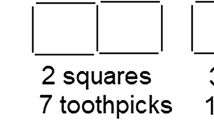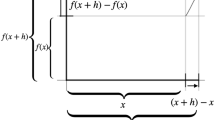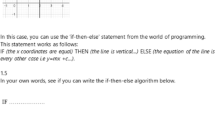Abstract
Since their appearance new technologies have raised many expectations about their potential for innovating teaching and learning practices; in particular any didactical software, such as a Dynamic Geometry System (DGS) or a Computer Algebra System (CAS), has been considered an innovative element suited to enhance mathematical learning and support teachers’ classroom practice. This paper shows how the teacher can exploit the potential of a DGS to overcome crucial difficulties in moving from an intuitive to a deductive approach to geometry. A specific intervention will be presented and discussed through examples drawn from a long-term teaching experiment carried out in the 9th and 10th grades of a scientific high school. Focusing on an episode through the lens of a semiotic analysis we will see how the teacher’s intervention develops, exploiting the semiotic potential offered by the DGS Cabri-Géomètre. The semiotic lens highlights specific patterns in the teacher’s action that make students’ personal meanings evolve towards the mathematical meanings that are the objective of the intervention.

Similar content being viewed by others
Notes
When using the term “sign” we refer to the indissoluble relationship between signified and signifier. In the stream of other researchers (Radford 2003; Arzarello 2006) we developed the idea that meaning originates in the intricate interplay of signs (Bartolini Bussi and Mariotti 2008; for a thoughtful discussion see also Sfard 2000, p. 42ff).
The expression “Cabri figure” is meant to express both the image produced on the screen and its dynamic behaviour preserving the properties defined in its construction.
Actually, if we consider the whole set of tools available in a DGS, including for instance “measure of an angle”, “rotation of an angle” and the like, the set of possible constructions does not coincide with that attainable only with ruler and compasses. For a full discussion see Stylianides and Stylianides (2005).
References
Arzarello, F. (2006). Semiosis as a multimodal process. Relime (special issue), 267–299.
Arzarello, F., & Bartolini Bussi, M. (1998). Italian trends in research in mathematical education. A national case study from an international perspective. In A. Sierpinska & J. Kilpatrick (Eds.), Mathematics education as a research domain: A search for identity (Vol. 2, pp. 241–262). Dordrecht: Kluwer.
Arzarello, F., & Paola, D. (2007). Semiotic games: the role of the teacher. In J. H. Woo, H. C. Lew, K. S. Park, & D. Y. Seo (Eds.), Proceedings of the 31st Conference of the International Group for the Psychology of Mathematics Education (Vol. 2, pp. 17–24). Seoul: PME.
Bartolini Bussi, M. G. (1996). Mathematical discussion and perspective drawings in primary school. Education Studies in Mathematics, 31, 11–41.
Bartolini Bussi, M. G. (1998). Verbal interaction in mathematics classroom: a Vygotskian analysis. In H. Steinbring, M. G. Bartolini Bussi, & A. Sierpinska (Eds.), Language and communication in mathematics classrooms (pp. 65–84). Reston: NCTM.
Bartolini Bussi, M. G., & Mariotti, M. A. (2008). Semiotic mediation in the mathematics classroom: artefacts and signs after a Vygotskian perspective. In L. English, M. Bartolini Bussi, G. Jones, R. Lesh & D. Tirosh (Eds.), Handbook of international research in mathematics education, second revised edition (pp. 746–805). Mahwah, NJ: Lawrence Erlbaum.
Bartolini Bussi, M. G., Mariotti, M. A., & Ferri, F. (2005). Semiotic mediation in the primary school: Dürer glass. In M. H. G. Hoffmann, J. Lenhard & F. Seeger (Eds.), Activity and sign—grounding mathematics education. Festschrift for Michael Otte (pp. 77–90). New York: Springer.
Cerulli, M., & Mariotti, M. A. (2003). Building theories: working in a microworld and writing the mathematical notebook. In Proc. 27 PME Conference (Vol. 2, pp. 46–53), Hawaii.
Falcade, R., Laborde, C., & Mariotti, M. A. (2007). Approaching functions: Cabri tools as instruments of semiotic mediation. Educational Studies in Mathematics, 66(3), 317–333.
Hanna, G., & de Villiers, M. (Eds.). (2012). Proof and proving in mathematics education. New ICMI Study Series 15. New York: Springer.
Hölzl, R., Hoyles, C., & Noss, R. (1994). Geometrical relationships and dependencies in Cabri. Micromath, 10(3), 8–11.
Jones, K. (2000). Providing a foundation for a deductive reasoning: students’ interpretation when using dynamic geometry software and their evolving mathematical explanations. Educational Studies in Mathematics, 44(1–2), 55–85.
Kozulin, A. (2003). Psychological tools and mediated learning. In A. Kozulin, B. Gindis, V. S. Ageyev, & S. M. Miller (Eds.), Vygotsky’s Educational Theory in Cultural Context (pp. 15–38). Cambridge: Cambridge University Press.
Laborde, J.-M. & Bellemain, F. (1995). Cabri-géomètre II and Cabri-géomète II plus [computer program]. Dallas, USA: Texas Instruments; and Grenoble, France: Cabrilog.
Laborde, C., & Laborde, J. M. (1991). Problem solving in geometry: From microworlds to intelligent computer environments. In da Ponte, J. P. et al. (Eds.), Mathematical problem solving and new information technologies (pp. 177–192). NATO AS1 Series F, 89.
Lagrange, J.-B., & Monaghan, J. (2009). On the adoption of a model to interpret teachers’ use of technology in mathematics lessons. Paper presented in WG7. In Proceedings of the 6th ERME Conference, 28 January–1 February 2009, Lyon.
Lave, J. (1988). Cognition in practice. Boston, MA: Cambridge University Press.
Mariotti, M. A. (1996). Costruzioni in geometria. L’insegnamento della Matematica e delle Scienze Integrate, 19B(3), 261–288.
Mariotti, M. A. (2000). Introduction to proof: the mediation of a dynamic software environment. Educational Studies in Mathematics, 44(1–2), 25–53.
Mariotti, M. A. (2001). Justifying and proving in the Cabri environment. International Journal of Computers for Mathematical Learning, 6(3), 257–281.
Mariotti, M. A. (2006). Proof and proving in mathematics education. In A. Gutiérrez & P. Boero (Eds.), Handbook of research on the psychology of mathematics education (pp. 173–204). Rotterdam: Sense Publishers.
Mariotti, M. A. (2012a). Proof and proving as an educational task. In Proceedings of the 7th ERME Conference, 9–13 February, 2011, Fe Rzeszów.
Mariotti, M. A. (2012b). Proof and proving in the classroom: Dynamic Geometry Systems as tools of semiotic mediation. Research in Mathematics Education, 14(2), 163–185.
Mariotti, M. A., & Bartolini Bussi, M. G. (1998). From drawing to construction: teachers’ mediation within the Cabri environment. In Proceedings of the 22nd PME Conference (Vol. III, pp .247–254), Stellenbosh.
Mariotti, M. A., & Maracci, M. (2010). Un artefact comme outils de médiation sémiotique: une ressource pour l’enseignant. In G. Gueudet & L. Trouche (Eds.), Ressources vives. Le travail documentaire des professeurs en mathématiques (pp. 91–107) Rennes: Presses Universitaires de Rennes et INRP.
Mariotti, M. A., & Maracci, M. (2012). Resources for the teacher from a semiotic mediation perspective. In G. Gueudet, B. Pepin, & L. Trouche (Eds.), From text to ‘lived’ resources: Mathematics curriculum materials and teacher development (pp. 59–76). Berlin: Springer.
Radford, L. (2003). Gestures, speech, and the sprouting of signs: A semiotic-cultural approach to students’ types of generalization. Mathematical Thinking and Learning, 5(1), 37–70.
Schoenfeld, A. (1985). Mathematical problem solving. New York: Academic Press.
Sfard, A. (2000). Symbolizing mathematical reality into being: How mathematical discourse and mathematical objects create each other. In P. Cobb, E. Yackel, & K. McClain (Eds.), Symbolizing and communicating: Perspectives on mathematical discourse, tools, and instructional design (pp. 37–98). Mahwah, NJ: Lawrence Erlbaum.
Stylianides, G. J., & Stylianides, A. J. (2005). Validation of solutions of construction problems in dynamic geometry environments. International Journal of Computers for Mathematical Learning, 10, 31–47.
Vygotsky, L. S. (1978). Mind in society. The development of higher psychological processes. Harvard: Harvard University Press.
Author information
Authors and Affiliations
Corresponding author
Rights and permissions
About this article
Cite this article
Mariotti, M.A. Introducing students to geometric theorems: how the teacher can exploit the semiotic potential of a DGS. ZDM Mathematics Education 45, 441–452 (2013). https://doi.org/10.1007/s11858-013-0495-5
Accepted:
Published:
Issue Date:
DOI: https://doi.org/10.1007/s11858-013-0495-5




